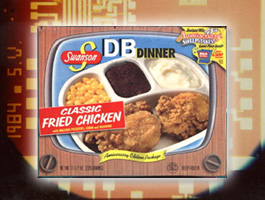From Thin Air
In the 1990's Star Trek, a popular science fiction television show featured a futuristic device called a replicator. The device was about the size of a microwave oven. In the setting of the show the unit was presented as a commonplace everyday appliance.
Science Fiction
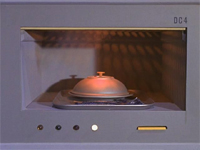 Replicator
Replicator
|

Fictional device?
The fictional device is described in the following excerpt supplied by Wikipedia (wikipedia.org the online encyclopedia):
"Origins and Limitations --
The replicator was introduced in Star Trek: The Next Generation installment of the series, being nonexistent on the original series (and arguably, in the 23rd century). It can replicate any inanimate matter, as long as a molecular structure is on file, but it cannot create either a living organism of any kind, antimatter, or dilithium.
Theory -- Theoretically, it works by rearranging subatomic particles, which are abundant anywhere in the universe, to form the molecules required by the formula at hand. The device then arranges the molecules in accordance with said formula to finally create the substance (e.g.: to materialize water, the replicator would first form hydrogen and oxygen molecules in immense quantities, and then arrange them according to the formula of water). The difficulty lies in that the number of calculations that a computer would have to perform in order to accomplish that is astounding, and at the rate of development of the computer industry, it is highly unlikely that even a 24th century computer would be capable of it (a similar dilemma concerns Transporter technology)."
The concept of creating an object on demand is not as far-fetched as it may seem. Current technology is capable of doing something similar, but unlike the TV version, today's technology cannot reassemble molecules, thus current methods require some kind of a stock material to be on hand, such as a block of resin, or liquid resin or as in the following example a wood plank. And, like the fictional version, a data file is also necessary.
Existing Technology
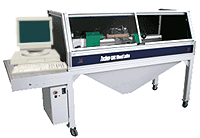 CNC Wood Lathe
CNC Wood Lathe
|

Replication using today's technology
A few years ago I had the good fortune to blueprint and help construct a web application for a crown moulding manufacturer. The company produced mouldings using a computer lathe. The computer lathe utilized a dfx or cad file containing numeric coordinates in order to shape a wood plank into the desired profile. The company employed us to build an online catalog showing the various moulding profiles. The client also requested us to develop a method to make the actual dfx/cad files available for download over the Net. We created a database to store their extensive library of moulding files -- it was necessary was to create a catalog, provide a search method, display the profiles and link each profile with its corresponding data file. Though the process was straight forward, the concept itself and it its implications were innovative.
Implications...
The immediate implications were significant. By placing this application on the web, we were in essence creating a system whereby anyone with an Internet connection and the proper computer lathe would be capable of manufacturing any of these mouldings "on demand." The system is similar to that of a printer -- as any computer user knows a printer can produce any document that can be downloaded -- the concept that were putting forth was the 3d version of remote printing.
Far-reaching implications
Existing Technology
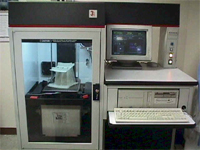 Stereo Lith
Stereo Lith
|

Today there are a number of devices, which belong to a category called "rapid prototyping" and "stereo lithography." These machines employ lasers to either harden or shape plastics and resins. They utilize data files with coordinates and they are capable producing the shape of just about any item. The current machines are fairly large and extremely expensive, but like all technology they will inevitably become smaller and more efficient over time. Delivery of the data files by Internet is not difficult and thus rapid prototyping can take place anywhere.
What does this mean for the retail consumer?
As time goes on I believe that a couple of things will take place, which will allow everyone to benefit from such developments. If consumer oriented rapid prototyping locations begin to establish themselves, eventually the consumer will be able to browse online catalogs for various products, such as sculpture, dinner ware, house ware or hardware and have the desired items produced on demand. Repair shops could have "out of production" parts replicated as needed, or sales people in the field could have new items in stock immediately.
In an article on rapid prototyping, MIT Technology Review stated-- "While these retail applications are still hypothetical, businesses are sprouting to serve manufacturers on a contract basis. Companies like Accelerated Technologies in Austin, TX, and Met-L-Flo in Geneva, IL, accept digital design files and make rapid prototypes-a concept that could evolve into custom-printing products for retail customers. If such a service does materialize, a neighborhood car restorer looking to duplicate a tiny piece of grillwork, or a homeowner replicating old trim, would find it akin to a digital Home Depot, with an infinite virtual stockroom of customized products." (MIT Technology Review, November 2003 - Ivan Amato)
Replicate at home...
Once the devices become less expensive and smaller, they could easily become a staple in the home. Anyone could have a replicator in his or her home, much like a printer today. The entire process could be streamlined to allow online searching, purchasing and "home" replicating immediately. Need a gift item? Just buy it online and produce it on your home replicator.
An economic shift and new business models...
Product manufacturers would undergo a major change in production, supply and distribution. A shift toward data licensing and focusing on the distribution of stock material would be imminent.
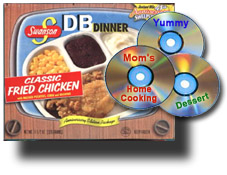
 TV Dinner vs. the DB Dinner
TV Dinner vs. the DB Dinner
Another possibility would be in the area of food production or preparation -- a similar device could be utilized to prepare specialty foods in the home kitchen. Theoretically a cartridge(s) containing an array of ingredients would be installed in a replicating device, which would then utilize downloaded recipe data to produce a desired food product.
The Long Term
As with most other forms of technology, new and better methods will continuously evolve and perhaps at some point a molecular version will someday become a reality.
Gigliotti, Lorenzo. "The Replicator." The Random Times Volume 1. #16 (2004):
14 pars. 07 Dec. 2025 <http://www.therandomtimes.com>.
